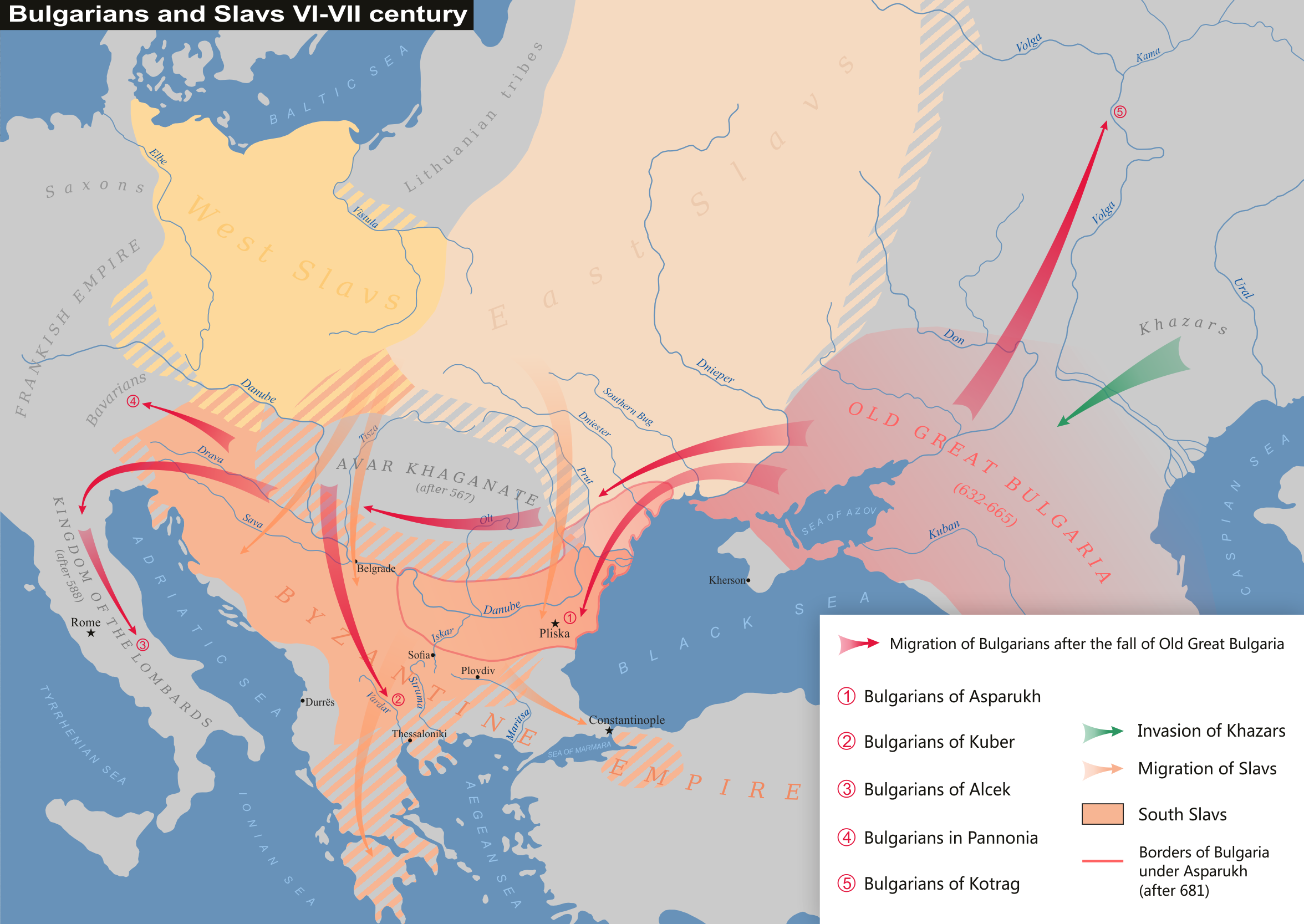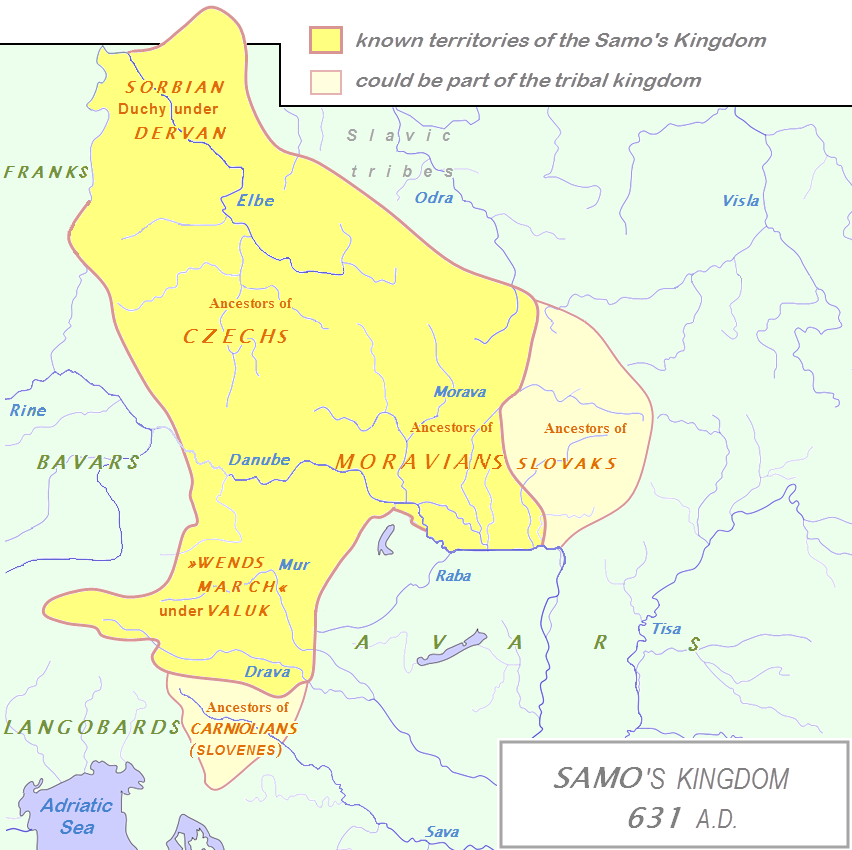|
Alciocus
Alcek or Alzeco was allegedly a son of Kubrat and led the Altsikurs to Ravenna that later settled in the villages of Gallo Matese, Sepino, Boiano and Isernia in the Matese mountains of southern Italy. Alzeco should not be confused with the Pannonian Bulgar leader Alciocus who joined the Wends before Alzeco was born. After the collapse of Old Great Bulgaria, some of the Bulgars, led by Alzeco, thought to be a son of Khan Kubrat, settled in the lands of the Longobard Kingdom. Paul the Deacon places a settlement in his history of the migration of the Bulgars in the area of the Duchy of Benevento. Under the leadership of Alzeco, the Bulgars (called "Vulgars" by Paul) came to Italy in Benevento, where they settled in the Molise region. Alciocus The earlier Khagan called Alciocus who was the leader of Bulgar hordes of the Avar Khanganate, is also known. The main source for these events is the medieval chronicle of Fredegar. In 631 Samo led a rebellion against the Pannonian Avars. A ... [...More Info...] [...Related Items...] OR: [Wikipedia] [Google] [Baidu] |
Pannonian Avars
The Pannonian Avars () were an alliance of several groups of Eurasian nomads of various origins. The peoples were also known as the Obri in chronicles of Rus, the Abaroi or Varchonitai ( el, Βαρχονίτες, Varchonítes), or Pseudo-Avars in Byzantine sources, and the Apar ( otk, 𐰯𐰺) to the Göktürks (). They established the Avar Khaganate, which spanned the Pannonian Basin and considerable areas of Central and Eastern Europe from the late 6th to the early 9th century. The name Pannonian Avars (after the area in which they settled) is used to distinguish them from the Avars of the Caucasus, a separate people with whom the Pannonian Avars might or might not have had links. Although the name ''Avar'' first appeared in the mid-5th century, the Pannonian Avars entered the historical scene in the mid-6th century, on the Pontic–Caspian steppe as a people who wished to escape the rule of the Göktürks. They are probably best known for their invasions and destructio ... [...More Info...] [...Related Items...] OR: [Wikipedia] [Google] [Baidu] |
Kubrat
Kubrat ( el, Κοβρᾶτος, Kούβρατος; bg, Кубрат ) was the ruler of the Onogur–Bulgars, credited with establishing the confederation of Old Great Bulgaria in ca. 632. His name derived from the Turkic words ''qobrat'' — "to gather", or ''qurt'', i.e. "wolf". Origin In the '' Nominalia of the Bulgarian khans'' Kubrat is mentioned as ''Kurt'' (), being a member of the Dulo clan and reigning for 60 years having succeeded Gostun of the Ermi clan. Bulgars were Turkic nomadic people, who participated in the 5th-century Hunnic confederation. Upon Attila's death, the tribes that later formed the Bulgars had retreated east into the Black Sea-Caspian Steppe. The western Bulgar tribes joined the Avar Khaganate, while the eastern Bulgars came under the Western Turkic Khaganate by the end of the 6th century. Theophanes the Confessor called him "king of the Onogundur Huns". Patriarch Nikephoros I (758–828) called Kubrat "lord of the Onuğundur" and "ruler of the ... [...More Info...] [...Related Items...] OR: [Wikipedia] [Google] [Baidu] |
Samo
Samo (–) founded the first recorded political union of Slavic tribes, known as Samo's Empire (''realm'', ''kingdom'', or ''tribal union''), stretching from Silesia to present-day Slovakia, ruling from 623 until his death in 658. According to Fredegarius, the only contemporary source, Samo was a Frankish merchant who unified several Slavic tribes against robber raids and violence by nearby settled Avars, showing such bravery and command skills in battle that he was elected as the "Slavic king" ( la, rex Sclavorum). In 631, Samo successfully defended his realm against the Frankish Kingdom in the three-day Battle of Wogastisburg. Reign The dates for Samo's rule are based on Fredegar, who says that he went to the Slavs in the fortieth year of Chlothar II (i.e., 623–24) and reigned for thirty five years.Curta, 109. The interpretation that places the start of Samo's reign in the year of Fredegar's arrival has been questioned on the basis that the Wends would have most li ... [...More Info...] [...Related Items...] OR: [Wikipedia] [Google] [Baidu] |
Campania
(man), it, Campana (woman) , population_note = , population_blank1_title = , population_blank1 = , demographics_type1 = , demographics1_footnotes = , demographics1_title1 = , demographics1_info1 = , demographics1_title2 = , demographics1_info2 = , demographics1_title3 = , demographics1_info3 = , timezone1 = CET , utc_offset1 = +1 , timezone1_DST = CEST , utc_offset1_DST = +2 , postal_code_type = , postal_code = , area_code_type = ISO 3166 code , area_code = IT-72 , blank_name_sec1 = GDP (nominal) , blank_info_sec1 = €108 billion (2018) , blank1_name_sec1 = GDP per capita , blank1_info_sec1 = €18,600 (2018) , blank2_name_sec1 = HDI (2018) , blank2_info_sec1 = 0.845 · 19th of 21 , blank_name_sec2 = NUTS Region , blank_info_sec2 = ITF , website ... [...More Info...] [...Related Items...] OR: [Wikipedia] [Google] [Baidu] |
Molise
it, Molisano (man) it, Molisana (woman) , population_note = , population_blank1_title = , population_blank1 = , demographics_type1 = , demographics1_footnotes = , demographics1_title1 = , demographics1_info1 = , demographics1_title2 = , demographics1_info2 = , demographics1_title3 = , demographics1_info3 = , timezone1 = CET , utc_offset1 = +1 , timezone1_DST = CEST , utc_offset1_DST = +2 , postal_code_type = , postal_code = , area_code_type = ISO 3166 code , area_code = IT-67 , blank_name_sec1 = GDP (nominal) , blank_info_sec1 = €6.5 billion (2018) , blank1_name_sec1 = GDP per capita , blank1_info_sec1 = €20,900 (2018) , blank2_name_sec1 = HDI (2018) , blank2_info_sec1 = 0.863 · 15th of 21 , blank_name_sec2 = NUTS Region , blank_info_sec2 = ITF , w ... [...More Info...] [...Related Items...] OR: [Wikipedia] [Google] [Baidu] |
Gastald
A gastald (Latin ''gastaldus'' or ''castaldus''; Italian ''gastaldo'' or ''guastaldo'') was a Lombard official in charge of some portion of the royal demesne (a gastaldate, ''gastaldia'' or ''castaldia'') with civil, martial, and judicial powers. By the ''Edictum Rothari'' of 643, the gastalds were given the civil authority in the cities and the reeves the like authority in the countryside. Under the Lombard dominion, territories were delimited by ''giudicati'' or "judgments" among the several gastalds. From the immediate region of Parma and of Piacenza, numerous such ''giudicati'' survive, which cover the range of Lombard rule. The documents follow the same formalized structure, of which one between the gastald Daghiberto and the gastald Immo was adjudged by Adaloald, at Ticino, November 615. As paid officials with direct allegiance to the roving Lombard kings, whose seat was nominally at Pavia, the gastalds were often in conflict with the dukes, the great Lombard territorial ... [...More Info...] [...Related Items...] OR: [Wikipedia] [Google] [Baidu] |
Ravenna
Ravenna ( , , also ; rgn, Ravèna) is the capital city of the Province of Ravenna, in the Emilia-Romagna region of Northern Italy. It was the capital city of the Western Roman Empire from 408 until its collapse in 476. It then served as the capital of the Ostrogothic Kingdom until it was re-conquered in 540 by the Byzantine Empire. Afterwards, the city formed the centre of the Byzantine Exarchate of Ravenna until the last exarch was executed by the Lombards in 751. Although it is an inland city, Ravenna is connected to the Adriatic Sea by the Candiano Canal. It is known for its well-preserved late Roman and Byzantine architecture, with eight buildings comprising the UNESCO World Heritage Site "Early Christian Monuments of Ravenna". History The origin of the name ''Ravenna'' is unclear. Some have speculated that "Ravenna" is related to "Rasenna" (or "Rasna"), the term that the Etruscans used for themselves, but there is no agreement on this point. Ancient era The origins o ... [...More Info...] [...Related Items...] OR: [Wikipedia] [Google] [Baidu] |
Grimoald I Of Benevento
Grimoald or Grimwald (c. 610 – 671) was a 7th-century King of Italy, ruling as Duke of Benevento from 647 to 662, and then as King of the Lombards from 662 until his death in 671.Chris Wickham, ''Early Medieval Italy: Central Power and Local Society, 400–1000'' (London: Macmillan, 1981), 224–25. Life Grimoald was born in 610 A.D. as the heir of Duke Gisulf II of Friuli and the Bavarian Princess Ramhilde, daughter of Duke Garibald I of Bavaria. From 641 to 642, he and his brother Radoald served as regents to Duke Aiulf I, their adoptive brother. In 647, Grimoald succeeded Radoald as Duke of Benevento.Andrea Bedina, "Grimoaldo, re dei Longobardi", ''Dizionario Biografico degli Italiani'', 59 (Rome: Istituto dell'Enciclopedia Italiana, 2003). In 662, he assassinated King Godepert and proclaimed himself King of the Lombards. He married Princess Theodota, daughter of King Aripert I. Reign Grimoald passed on the title of Duke of Benevento to his eldest son Romuald in 6 ... [...More Info...] [...Related Items...] OR: [Wikipedia] [Google] [Baidu] |
King Of The Lombards
The Kings of the Lombards or ''reges Langobardorum'' (singular ''rex Langobardorum'') were the monarchs of the Lombard people from the early 6th century until the Lombardic identity became lost in the 9th and 10th centuries. After 568, the Lombard kings sometimes styled themselves Kings of Italy (''rex totius Italiae''). After 774, they were not Lombards, but Franks. From the 12th century, the votive crown and reliquary known as the Iron Crown (''Corona Ferrea'') retrospectively became a symbol of their rule, though it was never used by Lombard kings. The primary sources for the Lombard kings before the Frankish conquest are the anonymous 7th-century '' Origo Gentis Langobardorum'' and the 8th-century ''Historia Langobardorum'' of Paul the Deacon. The earliest kings (the pre-Lethings) listed in the ''Origo'' are almost certainly legendary. They purportedly reigned during the Migration Period. The first ruler attested independently of Lombard tradition is Tato. Early rulers Leg ... [...More Info...] [...Related Items...] OR: [Wikipedia] [Google] [Baidu] |
Wends
Wends ( ang, Winedas ; non, Vindar; german: Wenden , ; da, vendere; sv, vender; pl, Wendowie, cz, Wendové) is a historical name for Slavs living near Germanic settlement areas. It refers not to a homogeneous people, but to various peoples, tribes or groups depending on where and when it was used. In the modern day, communities identifying as Wendish exist in Slovenia, Austria, Lusatia, Texas, and Australia. In German-speaking Europe This article details the geographical distribution of speakers of the German language, regardless of the legislative status within the countries where it is spoken. In addition to the German-speaking area (german: Deutscher Sprachraum) in Europ ... during the Middle Ages, the term "Wends" was interpreted as synonymous with "Slavs" and sporadically used in literature to refer to West Slavs and South Slavs living within the Holy Roman Empire. The name has possibly survived in Finnic languages ( , et, Vene , krl, Veneä), denoting moder ... [...More Info...] [...Related Items...] OR: [Wikipedia] [Google] [Baidu] |
Dagobert I
Dagobert I ( la, Dagobertus; 605/603 – 19 January 639 AD) was the king of Austrasia (623–634), king of all the Franks (629–634), and king of Neustria and Burgundy (629–639). He has been described as the last king of the Merovingian dynasty to wield any real royal power. Dagobert was the first of the Frankish kings to be buried in the royal tombs at Saint Denis Basilica. Rule in Austrasia Dagobert was the eldest son of Chlothar II and Haldetrude (575–604) and the grandson of Fredegund. Chlothar had reigned alone over all the Franks since 613. In 622, Chlothar made Dagobert king of Austrasia, almost certainly to bind the Austrasian nobility to the ruling Franks. As a child, Dagobert lived under the care of the Carolingian dynasty forebears and Austrasian magnates, Arnulf of Metz and Pepin of Landen. Chlothar attempted to manage the unstable alliances he had with other noble families throughout much of Dagobert's reign. When Chlothar granted Austrasia to Dagobert ... [...More Info...] [...Related Items...] OR: [Wikipedia] [Google] [Baidu] |





.jpg)
.png)

